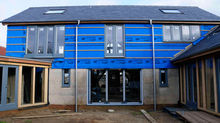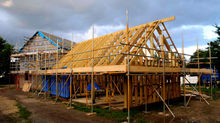Sunset On Solar

When planning my project I spent many hours considering renewable energy products. Being more suspicious than most I thoroughly researched the topic. The opinion and conclusions I arrived at were bespoke to my plot, my personal beliefs and my financial situation.
Renewable sources, (heat pumps and wood pellet boilers for example) combined with current government incentives, make obvious financial sense when ‘off gas’. However when ‘on gas’ they are not economical unless of course the cost of gas was to rise significantly. I would of preferred ‘green options’ but they were too costly for my ‘on gas’ plot and conservative budget.
I am personally yet to be fully convinced by the ‘green credentials’ of all the products available. The trend and fashion for eco bling makes it important to ask the right questions. Some of the questions I considered were:
What was the environmental impact of manufacture?
How long would the product last?
What was the real world efficiency?
What was the fossil fuel requirement to run or fuel the product?
Overall I believe many ‘green technologies’ are better environmentally than fossil fuelled alternatives but perhaps not always by the large margin we might expect.
I decided to concentrate on an alternative set of values given renewables were out of my reach. My house was constructed from a large percentage of natural materials and was designed to last a long time, potentially hundreds of years. When the structure comes to the end of its useful life most of it is biodegradable. I must though admit to sourcing my materials from a very wide base not just locally. My hope is that in time the highly insulated and long lasting natural build will offset this carbon cost.

One renewable I have always been fascinated by is solar power. To harness the energy from a summers day or the warming winter sun I think makes perfect sense. Gradually efficiency of electricity production from photovoltaic panels is improving. Sadly though even photovoltaics do not pay for themselves yet on a domestic scale. The government feed in and generation tariffs however bridged this gap.
It took hours of research, phone calls and quotes to decided on the best photovoltaic array. I had signed the agreement and was ready to pay the deposit. The same day the government announced planned cuts of 87% to the photovoltaic fed in tariff from January 2016. The array could be fitted in advance of the deadline but I could not register the system without a completed EPC (energy performance certificate) for the property. Providing the EPC before the end of December was impossible meaning I could only apply for the new reduced feed in tariff.
To my great disappointment a photovoltaic array was no longer a financially viable option for my project. Frustrating but lucky as had I installed them two weeks previously I would of made a large loss. I feel very sorry for those that work in the solar industry, as job losses are inevitable. Politics aside though it does show how cautious the self-builder needs to be in areas prone to policy change!
I remain optimistic for the future and hope one day my house will be one of many harnessing solar energy.






























